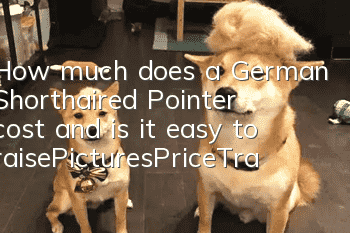How much does a German Shorthaired Pointer cost and is it easy to raise_Pictures|Price|Training

The German Shorthaired Pointer is also often used to track and capture deer, quail, grouse, partridge, woodcock, ducks, hares, raccoons and kangaroos. The lack of uncomfortable fur and webbed feet allow it to retrieve prey from difficult terrain or freezing water. The German Shorthaired Pointer possesses the excellent qualities that make a popular hunting dog. These qualities include a keen sense of smell, a high level of understanding, and have been incorporated into this breed through cross-breeding with descendants of Spanish Pointer Hounds, English Foxhounds, and German Native Tracking Dogs. Such breeding has resulted in this dog's ability in the wild. This adaptability has earned it the reputation of an "all-around dog." In fact, the Germans had given it this honor long before American athletes began to introduce the breed in 1920.
1. Introduction to the German Shorthaired Pointer
The main source of the basic breed of German Shorthaired Pointer appears to be the German Pointer, a dog inherited from the old Spanish Pointer and not very suitable for people's needs. Its usefulness was further enhanced as a result of the introduction of some local hounds and tracking-type dogs with keen senses of smell. These native types of dogs are also reliable in the water and are often used by German forest managers. They also come in a variety of types for local hounds with a keen sense of smell. Their origins spanned centuries, mainly from hounds introduced from some eastern countries after the Crusades, and developed mainly in France, so that they actually formed the ancestors of all modern olfactory hounds.
2. Characteristics of the German Shorthaired Pointer
Body size: The height of male dogs is generally 58.4-63.5cm. The height measurement of female dogs is the same as that of male dogs, generally 53.3-58.4cm. The weight of male dogs is 24.95-31.75kg, and the weight of female dogs is 20.41-27.22kg.
Head: Well defined, neither too small nor too large, and in good proportion to the body. Eyes - Medium in size, intelligent and expressive, neither convex nor sunken, almond-shaped, not round. The ears are broad, set high, flat and close to the cheeks; they are set slightly above eye level. The nose is brown, the bigger the better, the nostrils broad and well spread.
Body: The neck is well muscled and gradually becomes thicker towards the shoulders. A moderately hoarse voice is allowed. The chest generally gives the impression of being deeper than wide, but in good proportion to the rest of the body, reaching down to the elbows. Tail – The strong tail is set high and must be kept short.
Coat: The coat is short, thick and tough to the touch. The hair is slightly longer under the tail and on the back edge of the legs and buttocks. The hair on the ears and head is slightly softer, thinner and shorter. A dog with a long coat would be at a disadvantage in showing competitions.
Color: The coat is pure liver color or a combination of liver color and white. For example, liver color with small white spots, liver color spots mixed with white spots or yellowish brown. Dogs that are black, red, orange, light yellow, tan or pure white do not meet the standards.
Gait: When the gait changes from walking to fast running, the dog's limbs will be concentrated somewhere under the limbs, and dogs with a single trend of footprints are favored by people. The dog's forelimbs are stretched forward as much as possible, and the dog's back claws the ground hard. The appearance does not give people the gait of a driving horse. The hindquarters drive the hindquarters smoothly with great power.
3. Is the German Shorthaired Pointer easy to raise?
(1) During the feeding process, the German Shorthaired Pointer should be given adequate nutrition. In addition to feeding dog food, an appropriate amount of vegetables, lean meat, bread, fish, etc. should be given every day. In addition to drinking pure water, drinking water can also be Give him milk powder and calcium powder, which are very nutritious. When the nutrition is sufficient, the puppy's resistance will also improve.
(2) You should bathe your puppy at least once a week, preferably twice in summer, and dry him with a dry towel after bathing. It is best to go to a pet store to buy special shower gel for bathing. Do not use human shower gel to bathe your dog. That will not work.
(3) The German Shorthaired Pointer requires a certain amount of exercise to ensure its metabolism; therefore, owners should take their puppies out for a walk appropriately. Secondly, the German Shorthaired Pointer's resistance is relatively poor. In hot summer, he may have difficulty breathing. Therefore, the owner must ensure that the temperature of the dog's den should not be too high, and it is best to have ventilation.
4. German Shorthaired Pointer Hound Training
(1) Teaching based on “nature”
The “sex” here refers to the dog’s personality. When the owner is training, he must train according to the personality of his dog. Once you master the personality and find your dog’s hobbies, it will be easier to train him.
(2) Food induction
This training technique is very useful for any dog. Dogs are greedy by nature, so when training, owners can prepare the food that the dog likes in advance. For example, handshakes: When training dogs to shake hands, sit down, roll, lie down and other skills, food can be used to induce them, and the effect is very good.
(3)Reward and punishment system
The German Shorthaired Pointer is very loyal to its owner and longs for its owner's approval. During the training process, if the dog does very well, the owner can give appropriate rewards to stimulate his desire for training. If the dog is particularly naughty and cannot be controlled by the owner, the owner can punish him and make him train seriously.
5. How much does a German Shorthaired Pointer cost?
The price of the German Shorthaired Pointer Hound is relatively reasonable among pet dogs and is not too expensive. However, the price range is also relatively large, mainly affected by the dog’s age, size, gender, bloodline, and location. Generally, the price of a pointer hound just a few months old is about 800-1,000, and the price of an ordinary basset hound between 1 and 2 years old ranges from 2,000-3,000. The varieties are pure and sell relatively well, with prices above 3,000.
Guess you like it
"target="_blank">Saint Bernard, Bernese Mountain Dog, Papillon, German Black Shell, Czech Wolfdog
- Symptoms and Treatment of Golden Retriever Tonsillitis
- How long does it take for canine distemper to eat?
- Why is the puppy bleeding black water after more than 50 days of pregnancy?
- Losing weight is hard, we can choose to walk the dog more
- What to do if your dog miscarries at 40 days of pregnancy
- Dog holding training tips, a must-read for pet owners!
- How to train a German Shepherd? German Shepherd training tutorial!
- How to disinfect the kennel? What disinfectant is used to disinfect the kennel?
- Where does the Manchester Terrier originate from?
- Pets are in the golden moulting period in autumn and winter, so hair care should not be underestimated.



